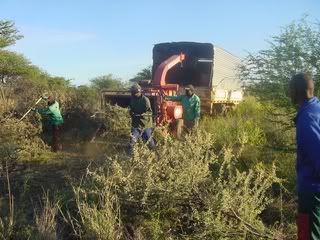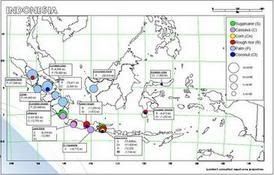Tata's Nano could trigger an unstoppable biofuels revolution in the Global South

Will Tata's "people's car" and other ultra-affordable vehicles trigger a biofuels revolution in developing countries?
At Biopact, we're strongly in favor of a transition to electric transport because it would be more efficient and versatile than the 20th century era of the internal combustion engine. In an electric-powered future, the energy carrier would be supplied from a diverse range of renewables, possibly backed up by nuclear, and of course, by the most radical kind of climate fighting energy: bio-electricity yielding negative emissions. That is, electricity generated from biomass cogeneration plants coupled to carbon capture and storage (CCS). Of all energy systems, only this one succeeds in generating electricity while at the same time actively removing carbon dioxide from the atmosphere.But let's be realistic: such a bright green future is decades away. Professor Jesse Ausubel from Rockefeller University’s Program for the Human Environment recently explored the temporal dimensions of such society-altering energy and transport transitions, in a highly interesting set of papers. He finds the timescales involved cover many decades and possibly even a century.
Still, it might be interesting to ask where this futuristic, all-electric mobility paradigm - possibly putting emphasis on mass transit systems - might emerge first. Somewhere in Silicon Valley, perhaps, or in resource-poor and heavily urbanised Japan. One thing is certain, though: it won't see the light in the developing world anywhere soon, no matter how appealing the concept of energy 'leapfrogging' might be on paper. The developing world will stick to the internal combustion engine for decades to come because it will remain by far the least expensive of all propulsion technologies.
Nano-revolution, biofuels revolution?
People in poorer countries - the "bottom of the pyramid" - aspire to enjoy a form of personal mobility, that is, to own and drive a normal family car. It remains the ultimate symbol of modernity and of membership of a kind of universal middle class. This explains the ever expanding trade of used cars that are shipped from Europe to Africa. This potentially huge market obviously also drives Tata's investment in the ultra-cheap Nano - the "people's car" some hail as a giant leap towards the democratisation of mobility, whereas others call it a potential (climate) disaster for the planet.
The Nano and similar hyper-affordable models currently under development by other manufacturers could expand oil demand much faster than expected. Peak Oil might arrive sooner because of this small car revolution. The numbers are quite staggering: according to rating agency CRISIL, Tata Nano’s launch and the price point it sets could by itself expand the Indian car market by a whopping 65%. At the significantly redefined threshold for car ownership in India, annual car sales have the potential to increase by 20% over the sales expected in 2007-08, it says. Another study by German research firm CSM World Wide shows the small car alone will propel the Tata to become the India's biggest light vehicle manufacturer by 2013. And then there are the large African, South East Asian and Latin American markets, all waiting for a seat aboard the Nano.
A scenario based on a very rapid expansion of the global car fleet and its effects on oil prices could have one immediate result: a massive and unstoppable rush into biofuels. Because the poor not only want to own their Nano, they want to drive it. Ultra-expensive gasoline simply won't be an option. However, the irony is that many of the Nano's target countries happen to have a very large biofuels potential. A considerable number of these nations can replace all petroleum imports by biofuels relatively easily (take Mozambique: it needs to devote less than 1% of its potential arable land to biofuels to meet all its current oil imports).
For the millions of new small car owners, biofuels - even with all their current drawbacks - would become the only acceptable alternative to unaffordable gasoline. The plant based fuels would be highly commercially attractive (they already are with oil near $100pb) and would be far cleaner than the only other fuel likely to be produced on a large scale, that is, coal-based liquid fuels. Coal-to-liquid fuels are known for their extremely high carbon emissions and comparatively high production costs:
 energy :: sustainability :: ethanol :: biodiesel :: biomass :: bioenergy :: biofuels :: mobility :: democratisation :: modernity :: consumerism :: Peak Oil :: electricity ::
energy :: sustainability :: ethanol :: biodiesel :: biomass :: bioenergy :: biofuels :: mobility :: democratisation :: modernity :: consumerism :: Peak Oil :: electricity :: In short, the Nano-revolution could imply an equally large biofuels revolution in the Global South. The small vehicle might be far more efficient than any European, Japanese or American car - but it too happens to have an internal combustion engine. That is, it needs a liquid fuel (gaseous (bio)fuels would do too). In any case, an electric Nano that is equally affordable will not see the light for a long time.
Liquid fuels and energy services
This brings us to a topic that has caused some confusion amongst renewable energy advocates. Many apply criteria to measure the efficiency of biofuels against other renewables, without taking into account the actual services provided by a liquid fuel. Take Nobel laureate Dr Hartmut Michel, the 1998 Nobel Prize winner for chemistry, who was in Manila last week for a talk. He urged the Philippine government to invest in wind power as an alternative to biofuels because the photosynthetic efficiency of plants is quite low. But obviously, the Nobel knows that cars don't work on wind power; he also knows that wind has problems with its intermittency and requires reliable baseloads, currently provided by fossil fuels. Moreover, Dr Michel should have known that the Philippines is an infrastructure-poor country that won't see electric vehicles anywhere soon. Instead, modernity in the island nation comes in the form of the ICE and liquid fuels. Currently, wind power has absolutely nothing to do with sustainable transport.
Bioenergy experts and scientists more familiar with the future of mobility know that the concept of the "energy balance" and production efficiency of biofuels - to which Dr Michel refers - is in a sense useless, certainly when this metric is used to compare biofuels to other forms of renewable energy, like wind power. This is so because a liquid fuel has very specific properties that make it unique and uncomparable with electricity, which is merely an energy carrier.
Bioenergy expert Professor Bruce Dale from Michigan State University recently claimed that "Net energy analysis is simple and has great intuitive appeal, but it is also dead wrong and dangerously misleading – net energy must be eliminated from our discourse." Dale’s perspective was recently published in the first edition of Biofuels, Bioproducts and Biorefining, to make the debate on the nascent bioeconomy more scientific and rigorous.
The problem with net energy, says Dale, is that it makes an assumption that all sources of energy (oil, coal, gas, nuclear, wind, etc) have equal value. "This assumption is completely wrong – all energy sources are not equal – one unit of energy from petrol is much more useful than the same amount of energy in coal, and that makes petrol much more valuable," says Dale.
For evidence, he points to the markets, where a unit of energy from gas, petrol and electricity are worth 3.5, 5 and 12 times as much as a unit of energy from coal, respectively. The same logic holds true for liquid biofuels compared with electricity from wind.
"Clear thinking shows that we value the services that energy can perform, not the energy per se, so it would be better to compare fuels by the services that each provides... not on a straight energy basis, which is likely to be irrelevant and misleading," says Dale.
It is an important lesson for everyone interested in analysing the future of mobility, especially as it relates to the developing world, where people value actual energy services more than the mere theoretical efficiency of an energy source.
Image: Tata Nano unveiled at the New Delhi Auto Expo. Credit: AFP.
References:
The Economic Times (India): Tata Nano may expand market by 65%: CRISIL - January 12, 2008.
The Economic Times (India): Tata Nano: Mass hysteria leaves vendors beaming - January 12, 2008.
New York Times: Moving Billions of People on a Still-Green Planet? - January 11, 2008.
Inquirer: Rethink biofuel, says Nobel laureate - January 14, 2008.
Article continues
 --------------
--------------
 Record warm summers cause extreme ice melt in Greenland: an international team of scientists, led by Dr Edward Hanna at the University of Sheffield, has found that recent warm summers have caused the most extreme Greenland ice melting in 50 years. The new research provides further evidence of a key impact of global warming and helps scientists place recent satellite observations of Greenland´s shrinking ice mass in a longer-term climatic context. Findings are published in the 15 January 2008 issue of Journal of Climate.
Record warm summers cause extreme ice melt in Greenland: an international team of scientists, led by Dr Edward Hanna at the University of Sheffield, has found that recent warm summers have caused the most extreme Greenland ice melting in 50 years. The new research provides further evidence of a key impact of global warming and helps scientists place recent satellite observations of Greenland´s shrinking ice mass in a longer-term climatic context. Findings are published in the 15 January 2008 issue of Journal of Climate.




 Governments may be getting a clearer picture of the shortcomings of current biofuel policies but the likelihood they can remedy any wrongs looks far from certain, a senior OECD official said on Monday.
Governments may be getting a clearer picture of the shortcomings of current biofuel policies but the likelihood they can remedy any wrongs looks far from certain, a senior OECD official said on Monday.







Monday, January 14, 2008
European Commission selects bioeconomy as part of 'Lead Market Initiative'; welcomed by biotech industry
These markets are seen as highly innovative, responding to customers’ needs, and having a strong technological and industrial base in Europe. They depend more than other markets on the creation of favourable framework conditions through public policy measures. For each market, a plan of actions for the next 3-5 years has been formulated. According to the Commission, European citizens will benefit both from the positive impact on growth and employment (the identified areas could represent three million jobs and €300 billion by 2020) and from the access to enhanced goods and services of high societal value.
The European biotech industry's umbrella organisation EuropaBio welcomes the communication particularly because it provides important support in the area of bio-based products, such as enzymes, biochemicals such as bio-based building-blocks or bioplastics, which will be produced together with bioenergy in future integrated "biorefineries". These renewable and biomass based products will replace fossil fuels (schematic: a tree of current and future bio-products from woody biomass, click to enlarge). By developing support policies and measures that will stimulate the demand for these products, this new policy will encourage innovation for bio-based products by transforming knowledge into new bioproducts and bioprocesses, the organisation says.
Over the last two years the biotech industry has supported the European Commission to work out a set of concrete steps to realise the vision of a Knowledge-Based Bio-Economy (KBBE), where biotechnology's new, clean, energy-efficient processes and innovative biobased products create a sustainable industrial base to ensure Europe's future prosperity. EuropaBio's "Industrial Biotechnology Policy Agenda for Europe" produced an outline of policy recommendations to develop a competitive KBBE in Europe, but recognized that in order for these recommendations to be implemented, political support was needed (previous post, see also the 'Plants for the Future' technology platform ).
According to the biotech organisation, encouraging public procurement for bio-based products, stimulating the demand via standards, developing an information and communication campaign explaining the benefits of these products, and looking for specific financial support for the establishment of biorefinery pilot and demonstration plants will certainly stimulate the development, production and uptake of bio-based products in Europe:
The Commission describes bio-based products as innovative products made from renewable, biological raw materials such as plants and trees. The long term growth potential for bio-based products will depend on their capacity to substitute fossil-based products and to satisfy various end-used requirements at a competitive cost.
Europe is well placed in the markets for innovative bio-based products, building on a leading technological and industrial position, the executive body of the Union says. Perceived uncertainty about product properties and weak market transparency however hinder the fast take-up of products.
The Commission's action plan for this lead market integrates all necessary actions in a synchronised way to favour the innovation of the new products and services. The actions range from improving the implementation of the present targets for bio-based products over standardisation, labelling and certification to ensure the quality and consumer information on the new products to harnessing the purchases of public authorities to show the way to the future.
According to the Commission European citizens will greatly benefit from reduced dependency on fossil products and of reduced emission of pollutants, through the wider use of these bio-based products. In the medium term, additional capacity could also help to reduce prices of average goods.
When it comes to renewables, the communication states that the European renewable energy sector has an annual turnover of €20 billion and provides jobs to 300.000 people while meeting approximately 8.5% of Europe's energy needs. The European Council in March 2007 set a binding target of a 20% share of EU energy consumption for renewable energy by 2020. But several problems remain:
• The external costs of energy use are not fully reflected in energy prices.
• Important learning curve effects which would lower prices in several technologies are exploited more slowly on account of present low levels of demand.
• The fragmentation of renewable energy support systems and the existence of administrative and market barriers mean that the potential of the internal market is not fully exploited.
The main elements of the renewable energy action plan are removing barriers to the integration of renewable energy sources in the EU energy system and simplifying authorisation procedures. A coordinated approach for standard setting and labelling on technologies as well as mobilising public and private financing are other measures to help reaching the 20% target by 2020.
EuropaBio's mission is to promote an innovative and dynamic biotechnology-based industry in Europe. EuropaBio, - the European Association for Bioindustries -, has 87 corporate and 8 associate members operating worldwide, 6 Bioregions and 25 national biotechnology associations representing some 1800 small and medium sized enterprises.
References:
European Commission, Enterprise and Industry, Innovation Policy: A Lead Market Initiative for Europe - January 2008.
European Commission, Research: Biosociety, the Knowledge-based Bio-Economy.
EuropaBio: Biotech industry welcomes European Commission's communication on European Lead Market Initiative - January 7, 2008.
Biopact: European biotech industry releases its policy on biofuels - August 18, 2007
Biopact: 'Plants for the Future' technology platform presents plan for European bioeconomy - July 02, 2007
Article continues
posted by Biopact team at 7:25 PM 0 comments links to this post
